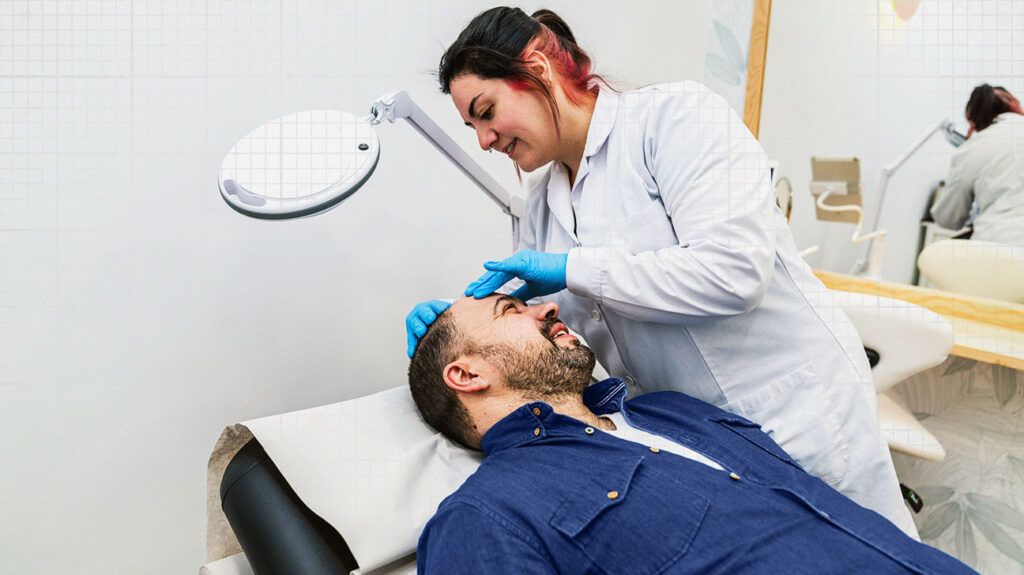Central centrifugal cicatricial alopecia (CCCA) is a type of scarring on a person’s scalp that may lead to permanent hair loss. However, people may be able to prevent or reverse it.
CCCA typically starts at the center of a person’s scalp. This hair loss then grows outward over time and at different rates for different people. CCCA was previously known as hot comb alopecia.
This article discusses the symptoms, causes, and diagnosis of CCCA. It also looks at treatments, reversing the condition, and more.

People with CCCA typically first develop noticeable hair loss on the top of their head.
People may also notice:
- Hair breakage: Part of a person’s hair may break off, making some of their hairs shorter than others. They may notice more hairs on a hairbrush or comb. Hair breakage may be the first sign of CCCA for some people.
- Scalp feels different: A person’s scalp may feel scaly, crusty, or have tiny bumps. People may experience this symptom before any hair loss.
- Outward hair loss: CCCA causes hair loss in a circular outward pattern starting from the top of the head.
- Shiny and smooth scalp: As CCCA progresses, it destroys a person’s hair follicles. Scar tissue then grows over them. This gives a person’s scalp a shiny smooth appearance.
CCCA may also cause other scalp symptoms, such as:
- itching
- pain
- tenderness
- burning
- stinging
- paresthesia
Paresthesia is an uncomfortable tingling or prickling sensation, also called pins and needles.
People with CCCA may experience these symptoms at different intensities, or sometimes not at all.
CCCA destroys a person’s hair follicles. These are small, tunnel shaped structures in a person’s skin that produce hair. As CCCA progresses, it destroys and replaces follicles with scars. This makes hair loss more likely to be permanent.
Scientists
Other possible causes of CCCA may include:
- infections
- autoimmune conditions, where a person’s immune system mistakenly attacks part of their body
- genetic factors
Learn about what can cause scabs on the scalp.
To reach an accurate diagnosis, a doctor may begin by closely examining the hair and scalp. They may then ask questions about:
- symptoms, such as scalp itching and tenderness
- whether the individual has noticed any hair loss
- hair care and styles
Doctors
If a doctor suspects a person has CCCA, they may perform a scalp biopsy. To do so, a doctor numbs part of a person’s scalp and removes a small sample of skin for analysis. This can help confirm whether a person has CCCA.
Treatments for CCCA can help prevent the condition or stop it from worsening. They also aim to encourage hair regrowth.
However, if CCCA has damaged a person’s hair follicles, then their hair will
Although there are no clear CCCA treatment guidelines, they may include:
- medications to stop hair loss and reduce inflammation, such as:
- topical corticosteroids that a person applies to their scalp
- oral corticosteroids
- corticosteroid injections
- calcineurin inhibitors, a topical medication
- antibiotics, such as doxycycline and minocycline
- vitamin D
A doctor may also recommend changes to a person’s hair care methods to help reduce damage.
If treatment starts before hair follicle scarring develops, it is sometimes possible to reverse CCCA.
Scientists have recently recorded some CCCA hair regrowth in clinical trials of
According to
Here are some frequently asked questions about CCCA.
Can hair grow back with central centrifugal cicatricial alopecia?
Some hair may grow back with CCCA if a person receives treatment before hair follicles develop scars.
Is there a cure for central centrifugal cicatricial alopecia?
There is no single cure for CCCA. However, with early treatment, healthcare professionals may be able to stop or regrow CCCA hair loss.
What is the best treatment for central centrifugal cicatricial alopecia?
The best treatment for each person with CCCA may vary based on individual factors. However, anti-inflammatory medications and antibiotics
A person’s doctor can help them design a treatment plan for their specific condition.
Central centrifugal cicatricial alopecia (CCCA) is a type of hair loss that can be permanent. Scientists do not yet know the exact cause of CCCA, but some treatments may help prevent further damage. Hair regrowth may also be possible in some cases.
If a person suspects they have CCCA, they should contact a doctor for advice. Early diagnosis and treatment can help reduce the risk of permanent hair loss.
